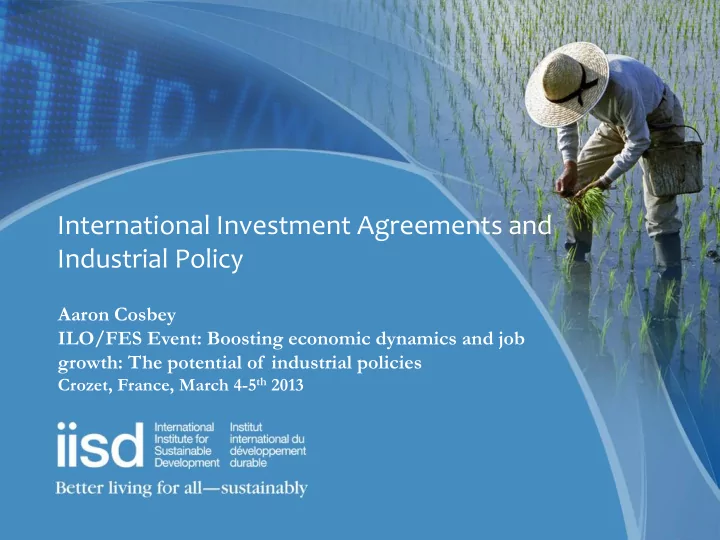

International Investment Agreements and Industrial Policy Aaron Cosbey ILO/FES Event: Boosting economic dynamics and job growth: The potential of industrial policies Crozet, France, March 4-5 th 2013
Overview • Starting points: context, definitions • Potential problems, solutions: • Performance requirements • IPRs • Broader IP: environmental policy • Concluding thoughts
Starting points • Context: No judgment as to effectiveness of IP instruments; no wider comments at this time about the legitimacy of the regime of IIAs • Industrial policy: pursuit by governments of national economic excellence in key sectors, with a view to creating globally competitive domestic firms (broad definition) • International Investment Agreements (IIAs): As found in BITs, FTAs, WTO’s TRIMS. Most contain provisions for binding investor-state dispute settlement.
Challenge: performance requirements • Performance requirements are conditions that include: • Demands for use of local content • Tech transfer requirements • Joint venture requirements • Demands for domestic R&D spending • Demands for some required level of exports • Classic instruments of industrial policy • Some IIAs ban certain performance requirements. Most do not.
Performance requirements • WTO’s TRIMs Agreement bans: • Local content requirements • Import limitations (e.g., as percentage of exports) • Export limitations • NAFTA’s Chapter 11 (and new EU practice) ban: • Local content requirements • Export requirements & links to domestic sales • Import limitations • Technology transfer requirements • Exclusive supplier requirements
Cases: Performance requirements • Local content: Mesa Power v. Canada (UNCITRAL, NAFTA): local content requirement to qualify for feed-in tariff to renewable energy in Ontario. Claim $775 million, Arbitration ongoing. • R&D requirement: Mobil Investments and Murphy Oil v. Canada (ICSID, NAFTA): requirements to invest amount in R&D, E&T, proportional to revenues. Won by claimant: $60 million. • Export requirements? No cases yet. Are these intrinsic to good IP practice?
Best practice • Draft EU language (from CETA): bans most types of performance requirements, but explicitly allows some requirements: • To locate production, provide a service • To train or employ workers • To construct or expand particular facilities • To conduct R&D in territory • SADC Model BIT: explicitly allows certain performance requirements, related to: • Employment levels, training • R&D and use of new technologies • Technology transfer
Best practice • IISD Model Agreement: • Explicitly allows any performance requirements elaborated at pre-establishment – deemed to be compliant. • Contains illustrative list. • Post-establishment, no prohibition; measures must respect obligations contained in the Agreement (e.g., fair and equitable treatment).
Challenge: IPRs • Correa argues that TRIPs Agreement allows for compulsory licensing in the event of non-working of a patent, including lack of local production . Controversial argument. • Local production demands may be a tool of industrial policy. If they are so used, and if they are WTO-legal (per Correa), they would likely run afoul of IIA provisions on expropriation. • All IIAs contain language on expropriation. Must be for public purpose, must be accompanied by compensation.
Cases: IPRs • Phillip-Morris v. Australia (UNCITRAL, HK- Australia BIT): challenging plain packaging laws on tobacco products as expropriation of intellectual property, arguing that IP is a protected investment. Case ongoing. • Eli Lilly v. Canada (NAFTA): challenging Canada’s standards for granting drug patents, claiming that denial of patent is an expropriation of property. Case ongoing. Claimed $100 million.
Best Practice • SADC Model BIT: Explicitly excludes coverage under expropriation article for compulsory licensing. • IISD Model Agreement: Defines investment so as to exclude intellectual property, so no coverage.
Challenge: Environmental Policy as IP • Can broad environmental policy be seen as industrial policy? Germany has explicitly pursued environmental policy with industrial policy goals for many years. • Germany’s nuclear energy ban can be seen as an attempt to steer the economy toward excellence in clean energy, as well as achieve other goals. Arguable point – little IP context to the decision.
Challenge: Environmental Policy as IP • Can broad environmental policy be seen as industrial policy? Germany has explicitly pursued environmental policy with industrial policy goals for many years. • Germany’s nuclear energy ban can be seen as an attempt to steer the economy toward excellence in clean energy, as well as achieve other goals. Arguable point – little IP context to the decision.
Environmental Policy as IP • All IIAs contain provisions on expropriation, including indirect expropriation. • Indirect (or “creeping”) expropriation does not involve a physical taking – it is an economic impact of regulation equivalent to a physical taking. • Case law under IIAs is completely unpredictable: in some cases pure economic impact is the test; in others a “police powers” carve out is applied.
Cases: Environmental Policy as IP • Vattenfall v. Germany (II) (ICSID, Energy Charter Treaty): Vattenfall argues that amendments to the Atomic Energy Act amount to expropriation of its investment in two nuclear power plants. Value of losses € 1.2 billion.
Best Practice • US Model BIT: Explicitly states that non- discriminatory measures in the public interest (e.g., environment, health) are not indirect expropriation subject to compensation. • SADC Model BIT: Non-discriminatory measure for legitimate public welfare objectives is not indirect expropriation.
Concluding thoughts • Performance requirement bans are perhaps the most palpable loss of policy space under IIAs. • Other types (IPRs, environmental policy) are more speculative in terms of risk, but worth watching. • There are straightforward fixes for future agreements; their value may be limited by MFN provisions. Existing agreements difficult to amend.
Aaron Cosbey, IISD acosbey@iisd.ca
Recommend
More recommend